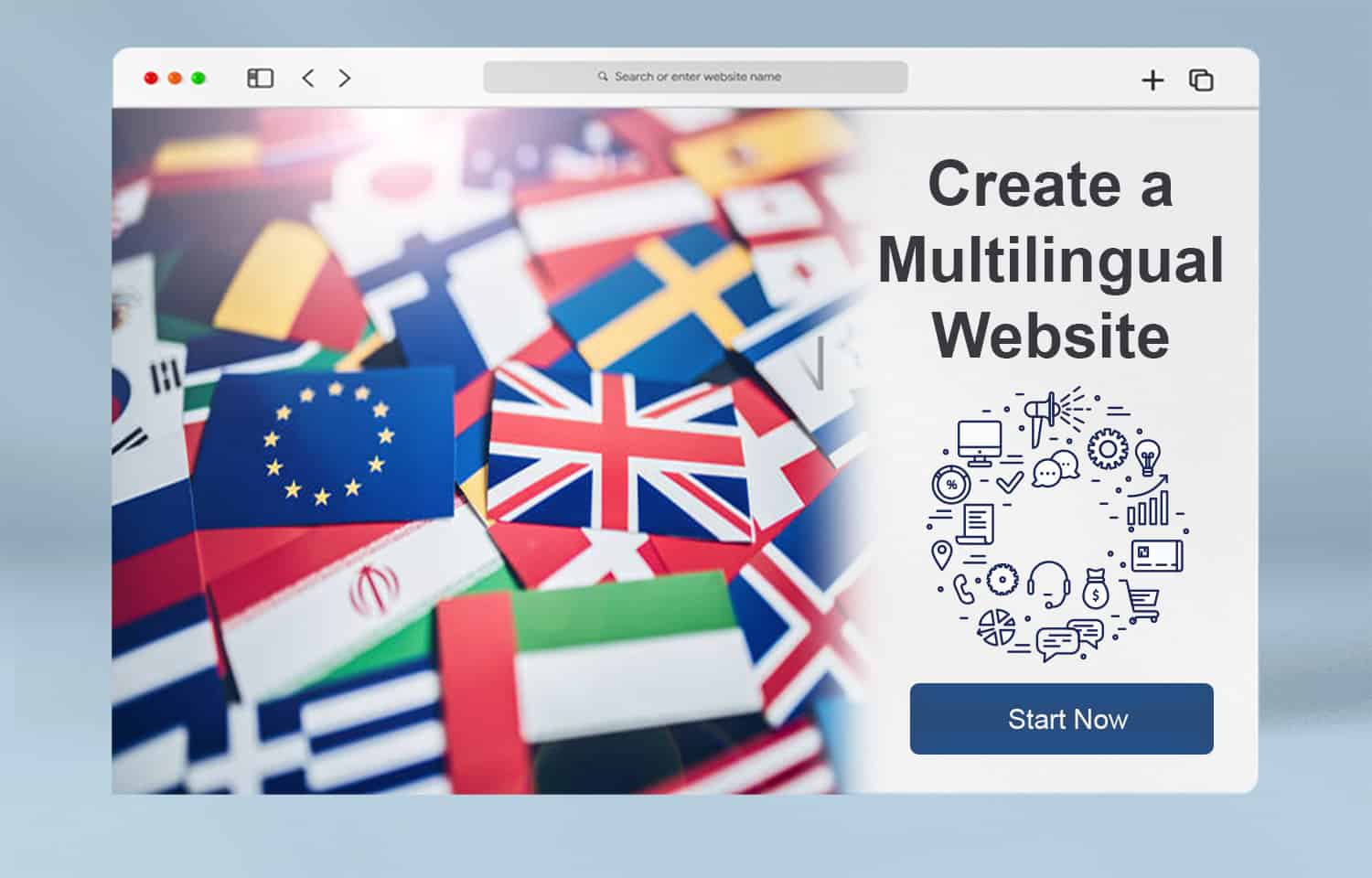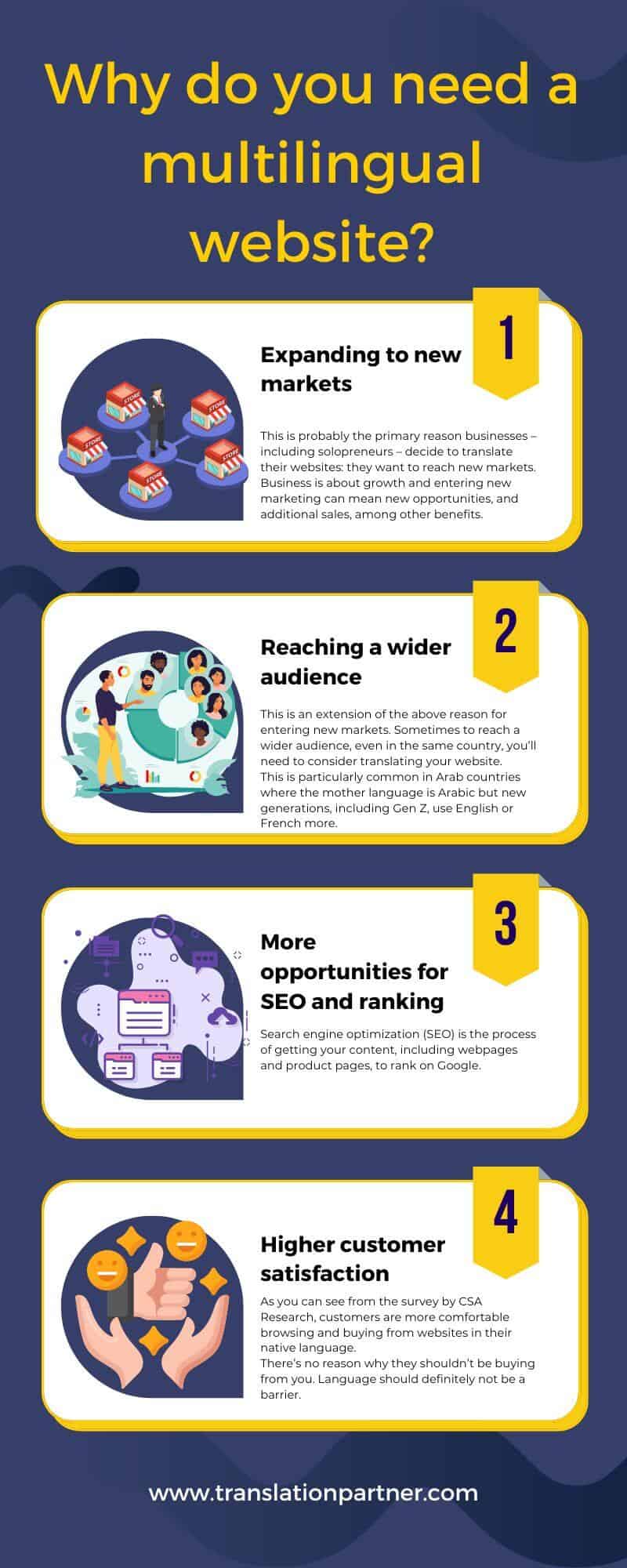4 Reasons Why You Need a Multilingual Website and How to Create One

E-commerce, software-as-a-service (SaaS), marketing technology, outsourcing, and many other opportunities are making it easier for businesses to connect with customers around the globe. But a barrier that often stands in the way of growth is the language barrier.
Data shows that 76% of online shoppers “prefer to buy products with information in their native language.” That 76% comes from over 8,700 global consumers from 29 countries. (CSA Research)
But it’s not just about preferences. There’s a level of trust involved. People, or buyers, trust websites that are written in their native language. The survey by CSA Research also found that 40% of consumers “will never buy from websites in other languages!”
That easily puts a dent in businesses’ grand hopes of expanding beyond their home country’s borders.
But there’s an easy, professional, and applicable solution to this. That’s creating a multilingual website. Companies and businesses in nearly all sectors are now relying on multilingual websites to expand their customer base, add revenue, and sell more.
In this article, we’ll be focusing on the reasons and benefits of creating a multilingual website and how to create one.
Why website translation is becoming more important
People have been relying on translation for thousands of years. And as people shift to the worldwide web and mobile apps, so has the need for translation in these areas.
Website translation is one of the most requested services today. Whether it’s an e-commerce business that wants to translate its website or a company that wants to translate online courses or an interior design firm that wants to reach more customers, or something else. Website translation is on the rise and will remain so in the coming years.
E-commerce translation has been in high demand since COVID-19 emerged in 2020. Buyer behavior has changed but online shopping is a habit that is expected to remain for many years to come. In fact, people are now turning to mobile apps to shop for their needs.
Similarly, e-commerce stores on websites like Magento, WooCommerce, and Shopify are using translation tools to create multilingual websites.
And it shouldn’t come as a surprise that e-commerce, compared to other industries, has a growing need for translation services.
By the end of 2021, global retail e-commerce sales amounted to $5.2 trillion! Wow, right? Statista forecasts that this figure will rise by 56% in the coming years, expecting $8.1 trillion by 2026.
E-commerce website builder Shopify also reported strong results at the end of 2021. Shopify reported $4.6 billion in total revenue in 2021, marking a year-over-year increase of 57%. The company also said that merchants on its platform sold products and services worth $175.4 billion in 2021.
People communicate using languages and translation, along with localization and transcreation, which are what businesses and people rely on to get their message across.
And with the rise in online purchases and transactions, there’s a growing need for creating multilingual websites.
What is a multilingual website?
In case we haven’t already clarified, a multilingual website is a website that offers more than language to people browsing the site.
E-commerce websites are probably the most common types and examples of bilingual and multilingual websites.
Another example of multilingual websites is streaming services. Netflix, Disney+, and Amazon Prime are now available in multiple languages because they cater to audiences around the world.
However, streaming services, it’s more than website translation. Their offering requires what’s known as subtitling translation or localization, which is the translation of the movie or series dialogue.
Now let’s explore the benefits of having a multilingual website.
Why do you need a multilingual website?
You’ve probably guessed that having a multi-language website comes with various benefits. But let’s zero in further on those benefits and what they can mean for you and your business.
1. Expanding to new markets
This is probably the primary reason businesses – including solopreneurs – decide to translate their websites: they want to reach new markets.
Business is about growth and entering new marketing can mean new opportunities, and additional sales, among other benefits.
So, one of the top reasons why you should consider a multilingual website is if you want to expand to new markets and reach customers who speak a different language.
2. Reaching a wider audience
This is an extension of the above reason for entering new markets. Sometimes to reach a wider audience, even in the same country, you’ll need to consider translating your website.
This is particularly common in Arab countries where the mother language is Arabic but new generations, including Gen Z, use English or French more.
This is also the case for many countries in Europe.
3. More opportunities for SEO and ranking
Search engine optimization (SEO) is the process of getting your content, including webpages and product pages, to rank on Google.
And a major benefit of having a multilingual website is making use of SEO in several languages. Put simply, this means getting your products and services to rank in more than one language.
Multilingual SEO can also contribute to your broader international SEO strategy. International SEO focuses on geo-targeting or location-based SEO. We recommend you follow the international SEO checklist to ensure you have everything you need.
4. Higher customer satisfaction
As you can see from the survey by CSA Research, customers are more comfortable browsing and buying from websites in their native language.
There’s no reason why they shouldn’t be buying from you. Language should definitely not be a barrier.
Having a bilingual website or multilingual one helps you reach out to more customers and reassures them to a great extent.
However, it’s worth mentioning here – and you’ve probably come across those sites yourself – that Google Translate isn’t the way to go when translating a website.
While translation costs are an important factor in your budget, you shouldn’t resort to ‘cheap’ translation options. Because ‘cheap’ can mean incorrect and sloppy translation, which is more likely to hurt your business than benefit it.
It’s worth noting that there are many factors that affect the cost of website translation, making each website translation project unique.

How to create a multilingual website
Now it’s time to look at what you need – in terms of tools – to create a multilingual website.
We’ll be looking at this list in brief:
1) Decide whether you’re going to translate your website or localize it. Both website translation and localization use Modern Standard Arabic. However, localization goes a step further by ensuring that the writing is country-specific.
2) Decide which language(s) you’ll be translating your website to.
3) Follow the website translation process along with multilingual website best practices to ensure your website is top-notch.
4) Consider working with a translation agency like TranslationPartner to speed up the translation process and ensure you’re getting adequate SEO translation. Depending on the size of your website and business, you may choose to hire a website localization team, a service offered by some agencies like TranslationPartner.
5) A/B test your new multilingual website.
Conclusion
Website translation has been gaining much interest in the past couple of years. And this need is likely to continue as more businesses turn from physical stores to e-commerce and omnichannel marketing.
As a business, expanding to a new market with a new audience can help your business and sales greatly. However, you must first conduct your market research and review your analytics to decide where your business has the best potential to grow.
A translation best practice we recommend is using a translation brief to ensure that you and your translators or agency are on the same page and you’re clear on deliverables.
Want to translate your website? Get in touch with TranslationPartner and our team will help you identify your needs and present you with a suitable quote and timeline.
